FORD F250 SUPER DUTY 2010 Owners Manual
Manufacturer: FORD, Model Year: 2010, Model line: F250 SUPER DUTY, Model: FORD F250 SUPER DUTY 2010Pages: 408, PDF Size: 5.48 MB
Page 101 of 408
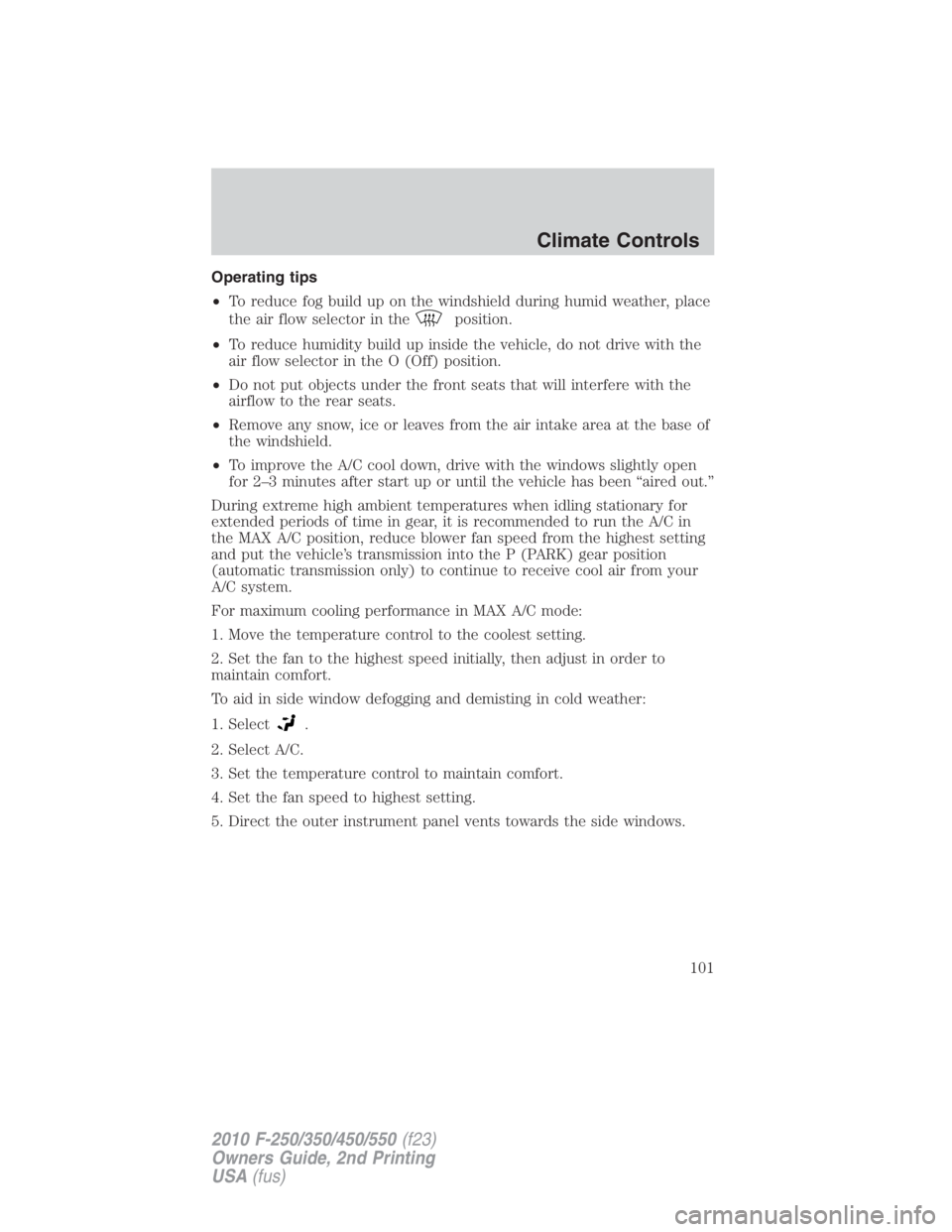
Operating tips
• To reduce fog build up on the windshield during humid weather, place
the air flow selector in the
position.
• To reduce humidity build up inside the vehicle, do not drive with the
air flow selector in the O (Off) position.
• Do not put objects under the front seats that will interfere with the
airflow to the rear seats.
• Remove any snow, ice or leaves from the air intake area at the base of
the windshield.
• To improve the A/C cool down, drive with the windows slightly open
for 2–3 minutes after start up or until the vehicle has been “aired out.”
During extreme high ambient temperatures when idling stationary for
extended periods of time in gear, it is recommended to run the A/C in
the MAX A/C position, reduce blower fan speed from the highest setting
and put the vehicle’s transmission into the P (PARK) gear position
(automatic transmission only) to continue to receive cool air from your
A/C system.
For maximum cooling performance in MAX A/C mode:
1. Move the temperature control to the coolest setting.
2. Set the fan to the highest speed initially, then adjust in order to
maintain comfort.
To aid in side window defogging and demisting in cold weather:
1. Select
.
2. Select A/C.
3. Set the temperature control to maintain comfort.
4. Set the fan speed to highest setting.
5. Direct the outer instrument panel vents towards the side windows. Climate Controls
101
2010 F-250/350/450/550 (f23)
Owners Guide, 2nd Printing
USA (fus)
Page 102 of 408
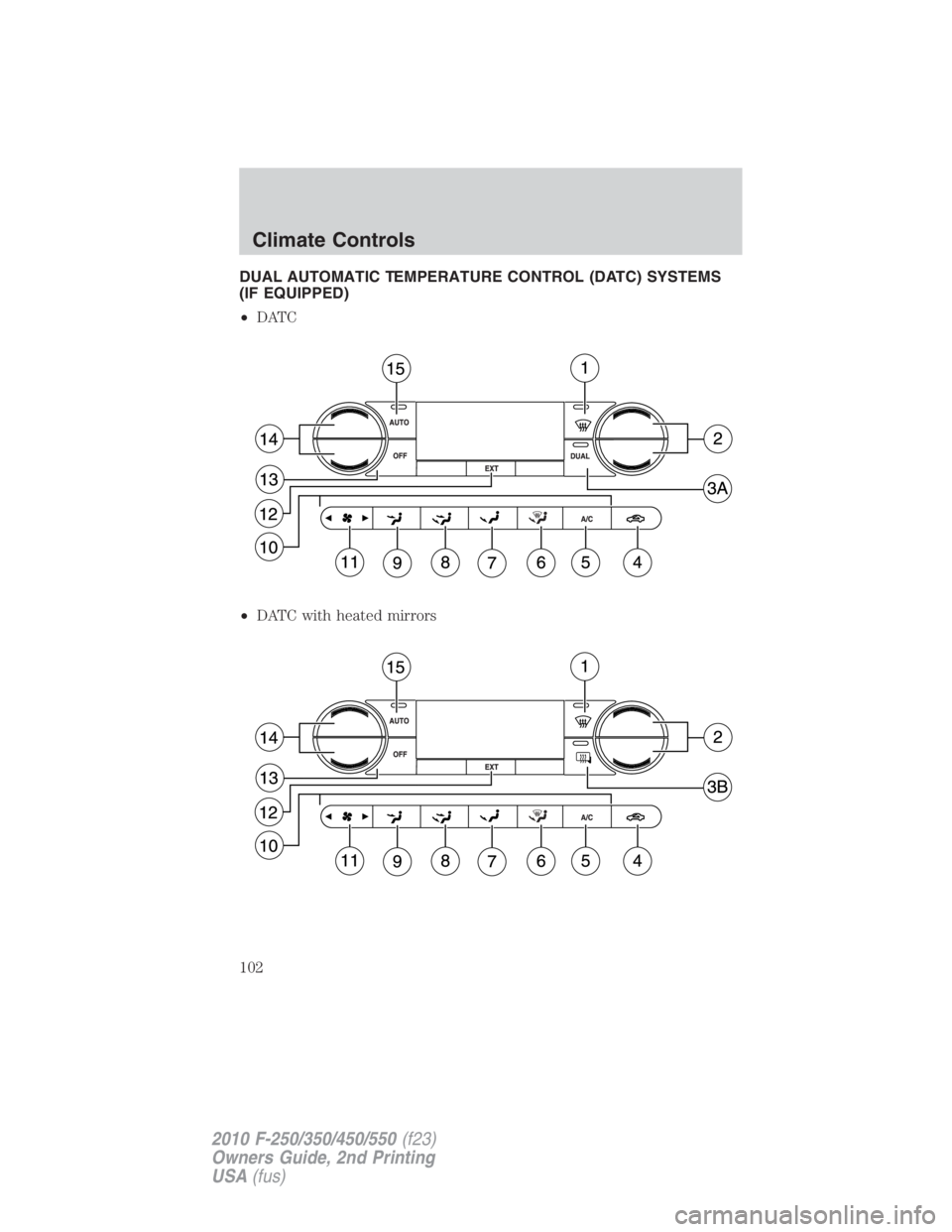
DUAL AUTOMATIC TEMPERATURE CONTROL (DATC) SYSTEMS
(IF EQUIPPED)
• DATC
• DATC with heated mirrorsClimate Controls
102
2010 F-250/350/450/550 (f23)
Owners Guide, 2nd Printing
USA (fus)
Page 103 of 408

• DATC with heated seats and heated mirrors
Temperature conversion: To switch between Fahrenheit and Celsius,
refer to Units (English/Metric) under either Standard Message Center
or Optional Message Center in the Driver Controls chapter
In order to achieve maximum cooling performance, press , A/C, ,
and set the temperature to 60°F (16°C) and the highest blower setting.
1. Defrost: Distributes outside air through the windshield defroster
and demister vents. Can be used to clear thin ice or fog from the
windshield. To exit select another mode.
2. Passenger temperature control: Press to increase/decrease the
passenger side temperature in the vehicle cabin.
3A. Dual: (Single/dual electric temperature control): Allows the driver to
have full control of the cabin temperature settings (single zone) or
allows the passenger to have control of their individual temperature
settings (dual zone control). Press to turn on dual zone mode, press
again to return to single zone.
3B. Heated mirrors: Press to defrost the outside rear view
mirrors. The heated mirrors will turn off after 10 minutes or can be
turned off by pressing the button again. Refer to Power mirrors in the
Driver Controls chapter for more information. Climate Controls
103
2010 F-250/350/450/550 (f23)
Owners Guide, 2nd Printing
USA (fus)
Page 104 of 408
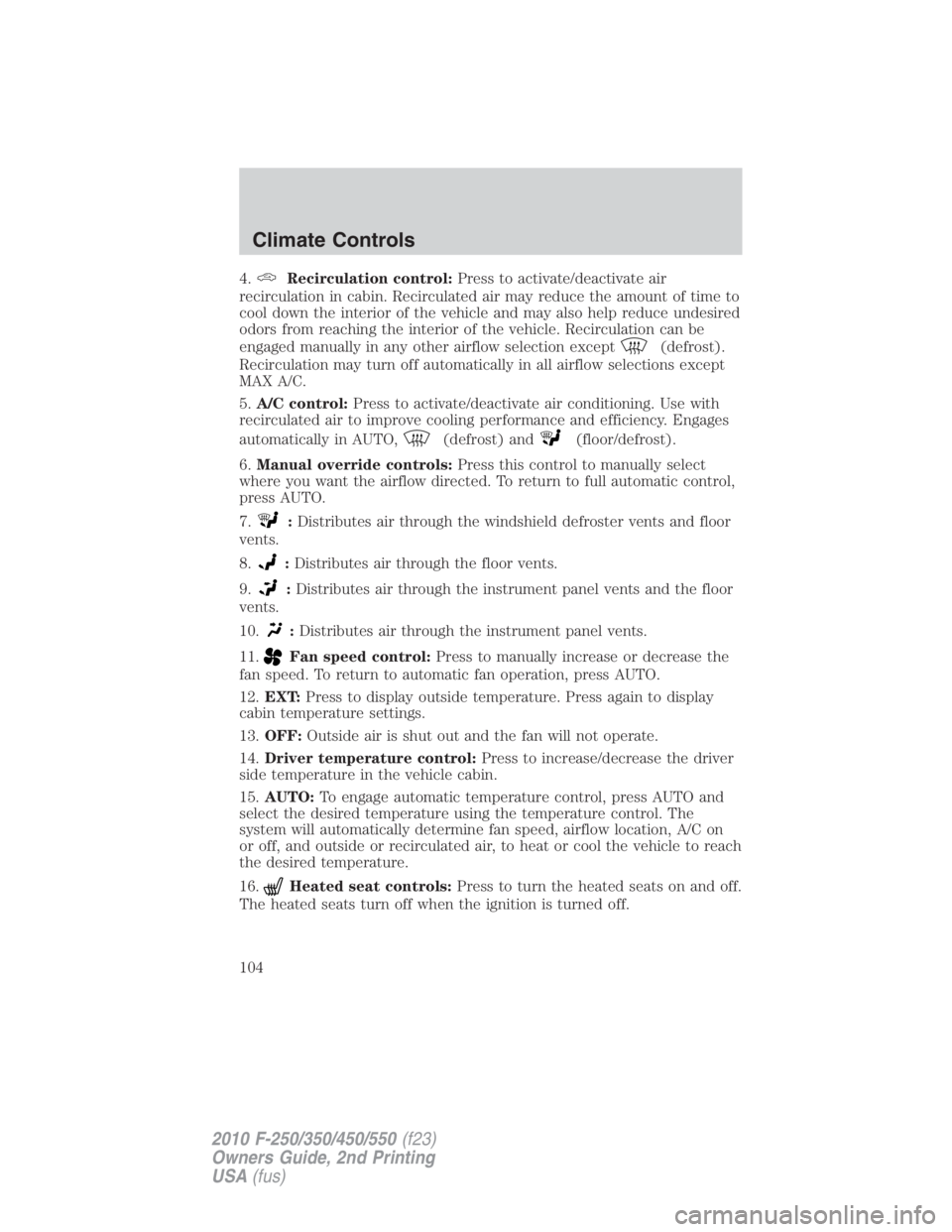
4. Recirculation control: Press to activate/deactivate air
recirculation in cabin. Recirculated air may reduce the amount of time to
cool down the interior of the vehicle and may also help reduce undesired
odors from reaching the interior of the vehicle. Recirculation can be
engaged manually in any other airflow selection except (defrost).
Recirculation may turn off automatically in all airflow selections except
MAX A/C.
5. A/C control: Press to activate/deactivate air conditioning. Use with
recirculated air to improve cooling performance and efficiency. Engages
automatically in AUTO, (defrost) and (floor/defrost).
6. Manual override controls: Press this control to manually select
where you want the airflow directed. To return to full automatic control,
press AUTO.
7. : Distributes air through the windshield defroster vents and floor
vents.
8. : Distributes air through the floor vents.
9. : Distributes air through the instrument panel vents and the floor
vents.
10. : Distributes air through the instrument panel vents.
11. Fan speed control: Press to manually increase or decrease the
fan speed. To return to automatic fan operation, press AUTO.
12. EXT: Press to display outside temperature. Press again to display
cabin temperature settings.
13. OFF: Outside air is shut out and the fan will not operate.
14. Driver temperature control: Press to increase/decrease the driver
side temperature in the vehicle cabin.
15. AUTO: To engage automatic temperature control, press AUTO and
select the desired temperature using the temperature control. The
system will automatically determine fan speed, airflow location, A/C on
or off, and outside or recirculated air, to heat or cool the vehicle to reach
the desired temperature.
16. Heated seat controls: Press to turn the heated seats on and off.
The heated seats turn off when the ignition is turned off.Climate Controls
104
2010 F-250/350/450/550 (f23)
Owners Guide, 2nd Printing
USA (fus)
Page 105 of 408
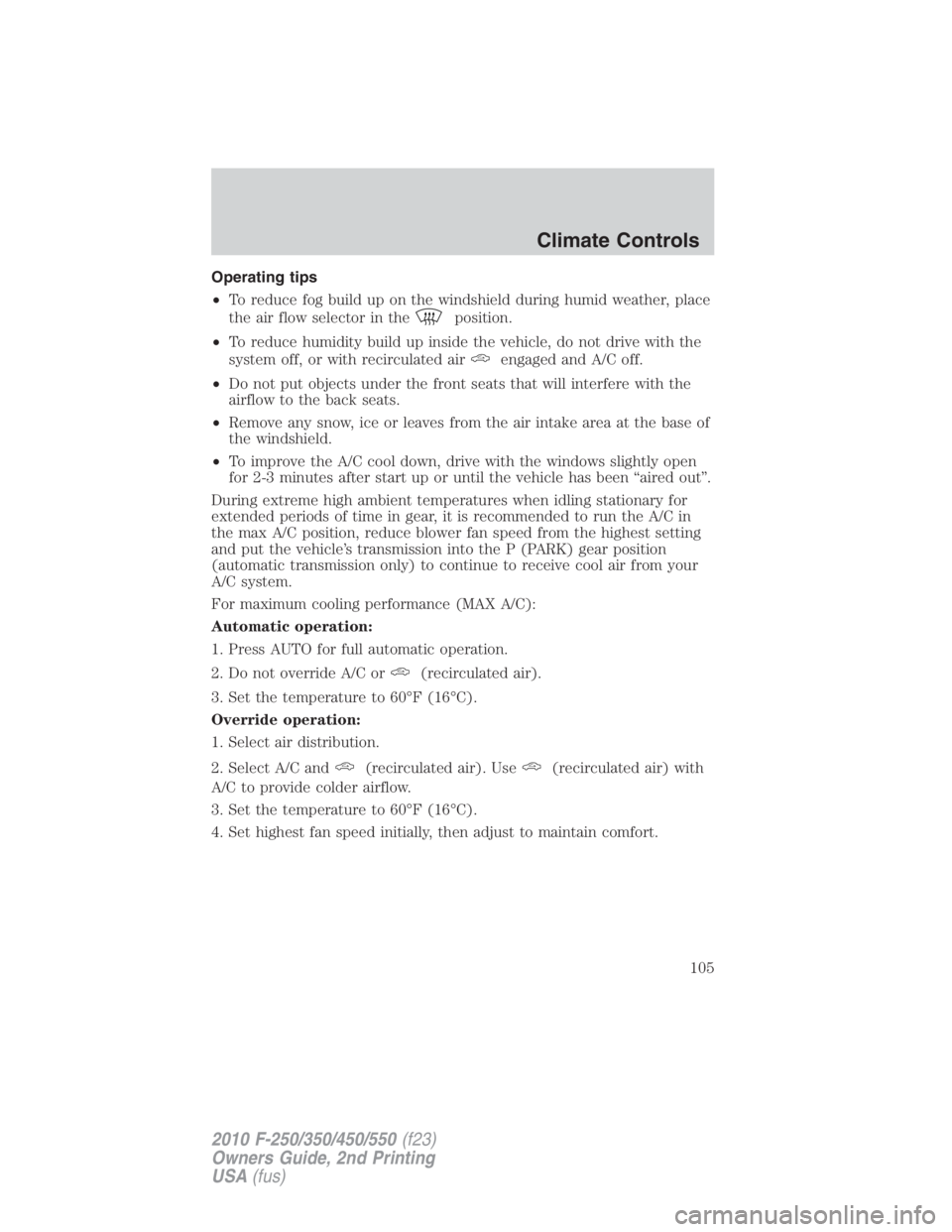
Operating tips
• To reduce fog build up on the windshield during humid weather, place
the air flow selector in the position.
• To reduce humidity build up inside the vehicle, do not drive with the
system off, or with recirculated air engaged and A/C off.
• Do not put objects under the front seats that will interfere with the
airflow to the back seats.
• Remove any snow, ice or leaves from the air intake area at the base of
the windshield.
• To improve the A/C cool down, drive with the windows slightly open
for 2-3 minutes after start up or until the vehicle has been “aired out”.
During extreme high ambient temperatures when idling stationary for
extended periods of time in gear, it is recommended to run the A/C in
the max A/C position, reduce blower fan speed from the highest setting
and put the vehicle’s transmission into the P (PARK) gear position
(automatic transmission only) to continue to receive cool air from your
A/C system.
For maximum cooling performance (MAX A/C):
Automatic operation:
1. Press AUTO for full automatic operation.
2. Do not override A/C or (recirculated air).
3. Set the temperature to 60°F (16°C).
Override operation:
1. Select air distribution.
2. Select A/C and (recirculated air). Use (recirculated air) with
A/C to provide colder airflow.
3. Set the temperature to 60°F (16°C).
4. Set highest fan speed initially, then adjust to maintain comfort. Climate Controls
105
2010 F-250/350/450/550 (f23)
Owners Guide, 2nd Printing
USA (fus)
Page 106 of 408
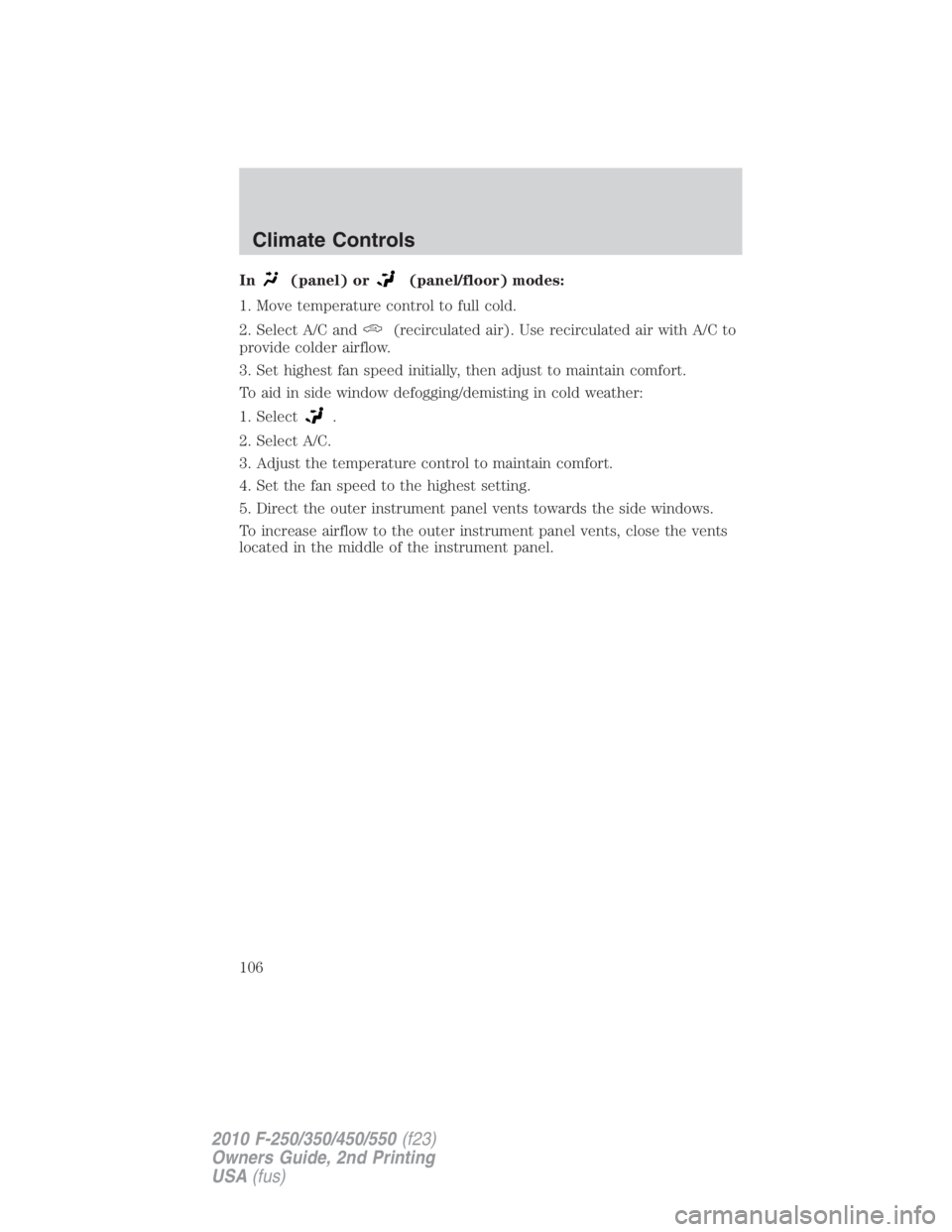
In (panel) or (panel/floor) modes:
1. Move temperature control to full cold.
2. Select A/C and (recirculated air). Use recirculated air with A/C to
provide colder airflow.
3. Set highest fan speed initially, then adjust to maintain comfort.
To aid in side window defogging/demisting in cold weather:
1. Select .
2. Select A/C.
3. Adjust the temperature control to maintain comfort.
4. Set the fan speed to the highest setting.
5. Direct the outer instrument panel vents towards the side windows.
To increase airflow to the outer instrument panel vents, close the vents
located in the middle of the instrument panel.Climate Controls
106
2010 F-250/350/450/550 (f23)
Owners Guide, 2nd Printing
USA (fus)
Page 107 of 408
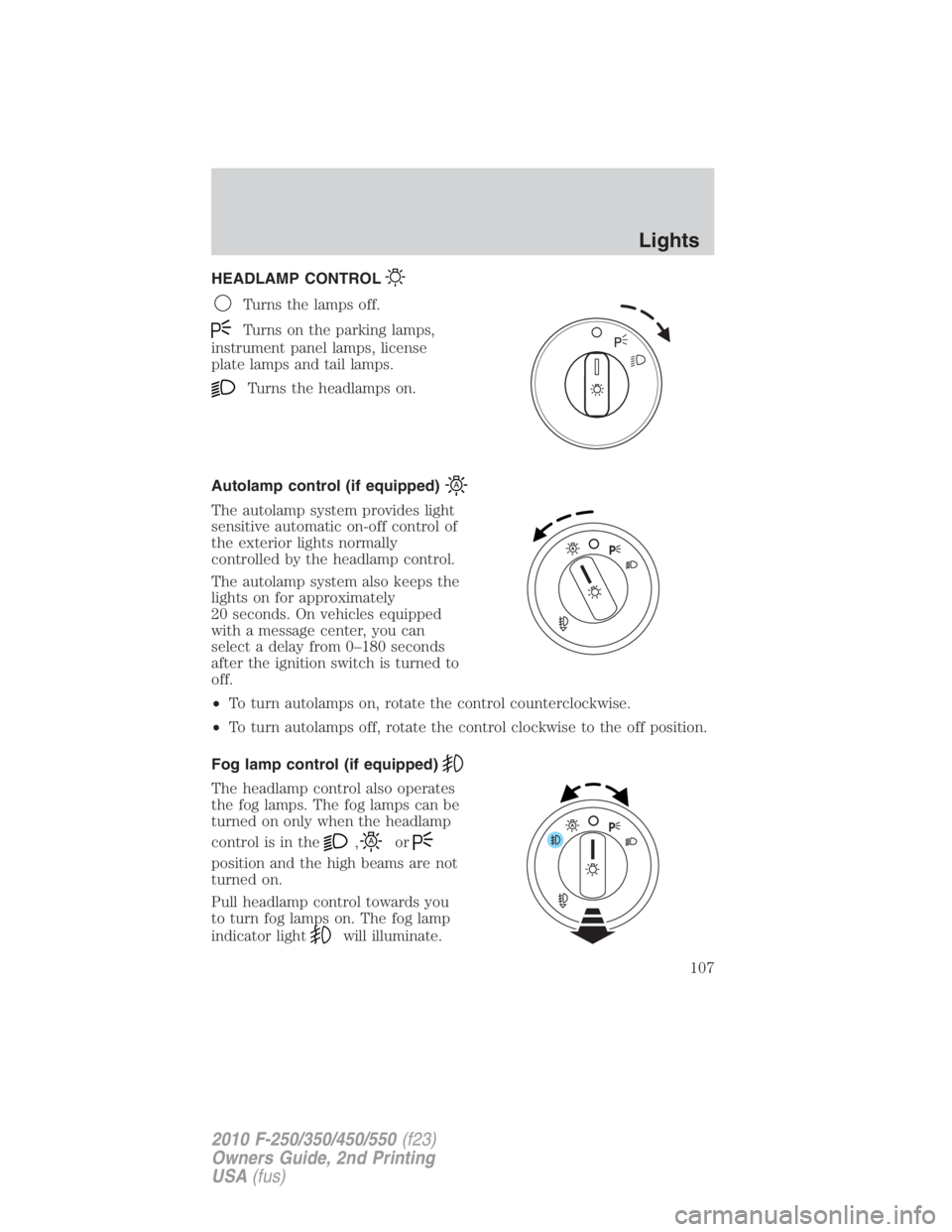
HEADLAMP CONTROL
Turns the lamps off.
Turns on the parking lamps,
instrument panel lamps, license
plate lamps and tail lamps.
Turns the headlamps on.
Autolamp control (if equipped)
The autolamp system provides light
sensitive automatic on-off control of
the exterior lights normally
controlled by the headlamp control.
The autolamp system also keeps the
lights on for approximately
20 seconds. On vehicles equipped
with a message center, you can
select a delay from 0–180 seconds
after the ignition switch is turned to
off.
• To turn autolamps on, rotate the control counterclockwise.
• To turn autolamps off, rotate the control clockwise to the off position.
Fog lamp control (if equipped)
The headlamp control also operates
the fog lamps. The fog lamps can be
turned on only when the headlamp
control is in the , or
position and the high beams are not
turned on.
Pull headlamp control towards you
to turn fog lamps on. The fog lamp
indicator light will illuminate. Lights
107
2010 F-250/350/450/550 (f23)
Owners Guide, 2nd Printing
USA (fus)
Page 108 of 408
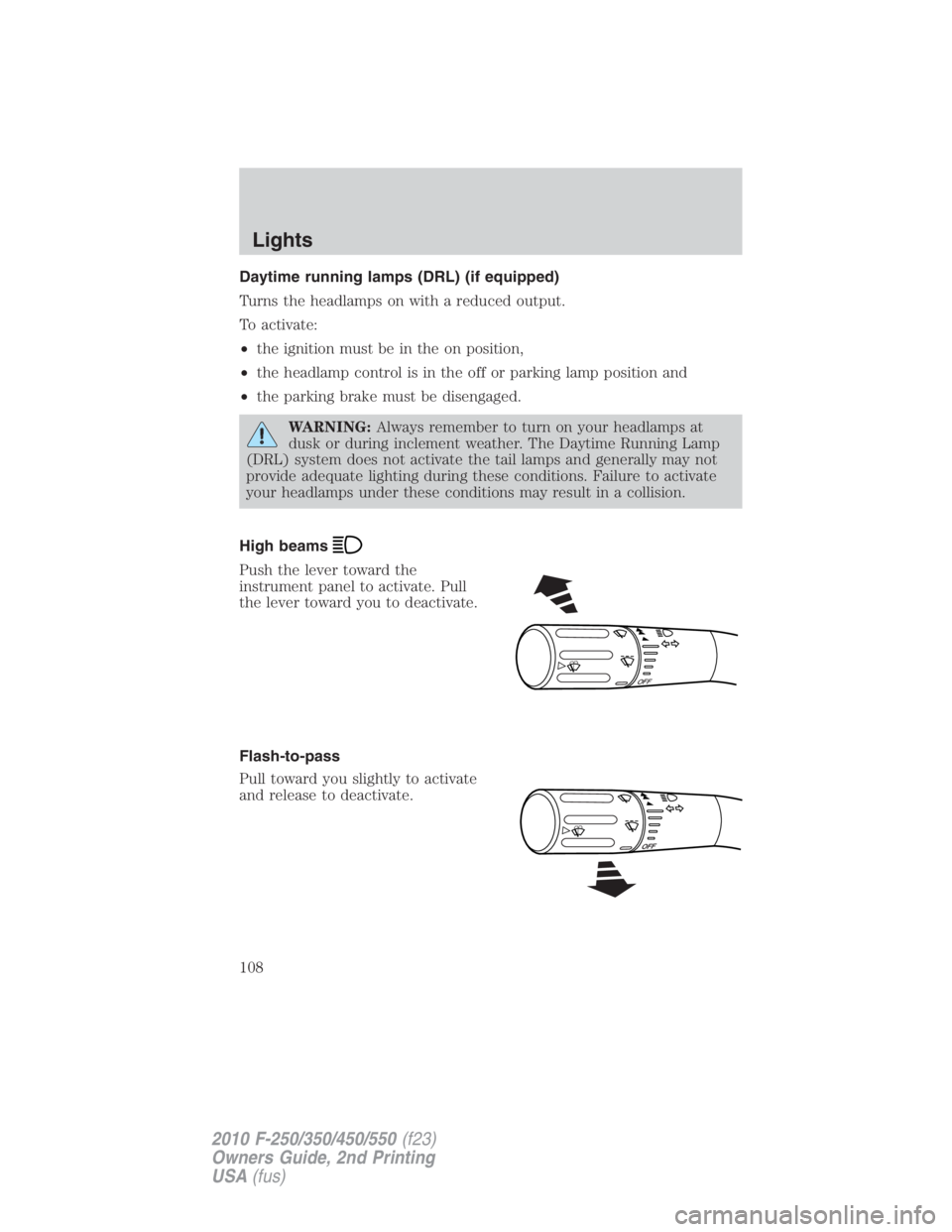
Daytime running lamps (DRL) (if equipped)
Turns the headlamps on with a reduced output.
To activate:
• the ignition must be in the on position,
• the headlamp control is in the off or parking lamp position and
• the parking brake must be disengaged.
WARNING: Always remember to turn on your headlamps at
dusk or during inclement weather. The Daytime Running Lamp
(DRL) system does not activate the tail lamps and generally may not
provide adequate lighting during these conditions. Failure to activate
your headlamps under these conditions may result in a collision.
High beams
Push the lever toward the
instrument panel to activate. Pull
the lever toward you to deactivate.
Flash-to-pass
Pull toward you slightly to activate
and release to deactivate. O F F
Lights
108
2010 F-250/350/450/550 (f23)
Owners Guide, 2nd Printing
USA (fus)
Page 109 of 408
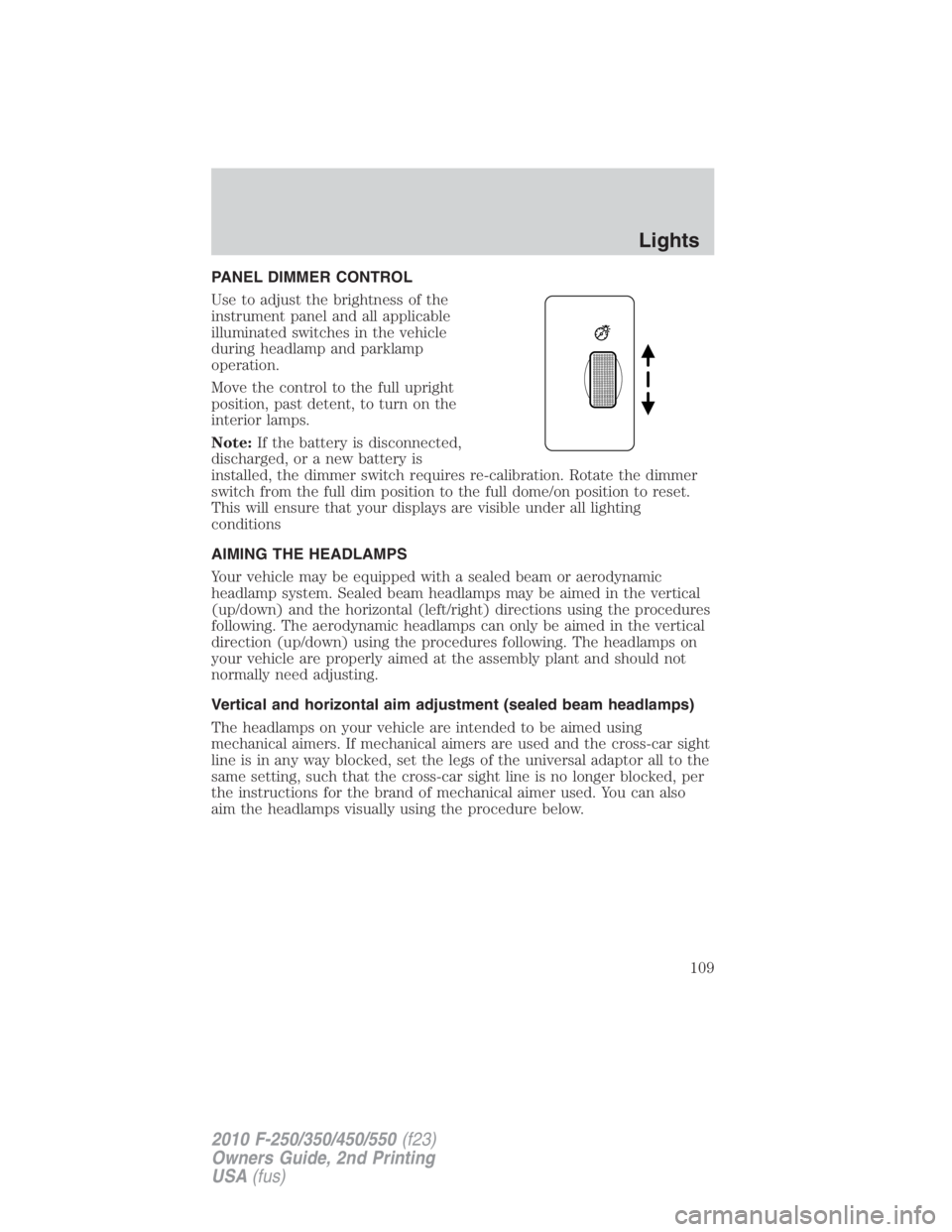
PANEL DIMMER CONTROL
Use to adjust the brightness of the
instrument panel and all applicable
illuminated switches in the vehicle
during headlamp and parklamp
operation.
Move the control to the full upright
position, past detent, to turn on the
interior lamps.
Note: If the battery is disconnected,
discharged, or a new battery is
installed, the dimmer switch requires re-calibration. Rotate the dimmer
switch from the full dim position to the full dome/on position to reset.
This will ensure that your displays are visible under all lighting
conditions
AIMING THE HEADLAMPS
Your vehicle may be equipped with a sealed beam or aerodynamic
headlamp system. Sealed beam headlamps may be aimed in the vertical
(up/down) and the horizontal (left/right) directions using the procedures
following. The aerodynamic headlamps can only be aimed in the vertical
direction (up/down) using the procedures following. The headlamps on
your vehicle are properly aimed at the assembly plant and should not
normally need adjusting.
Vertical and horizontal aim adjustment (sealed beam headlamps)
The headlamps on your vehicle are intended to be aimed using
mechanical aimers. If mechanical aimers are used and the cross-car sight
line is in any way blocked, set the legs of the universal adaptor all to the
same setting, such that the cross-car sight line is no longer blocked, per
the instructions for the brand of mechanical aimer used. You can also
aim the headlamps visually using the procedure below. Lights
109
2010 F-250/350/450/550 (f23)
Owners Guide, 2nd Printing
USA (fus)
Page 110 of 408
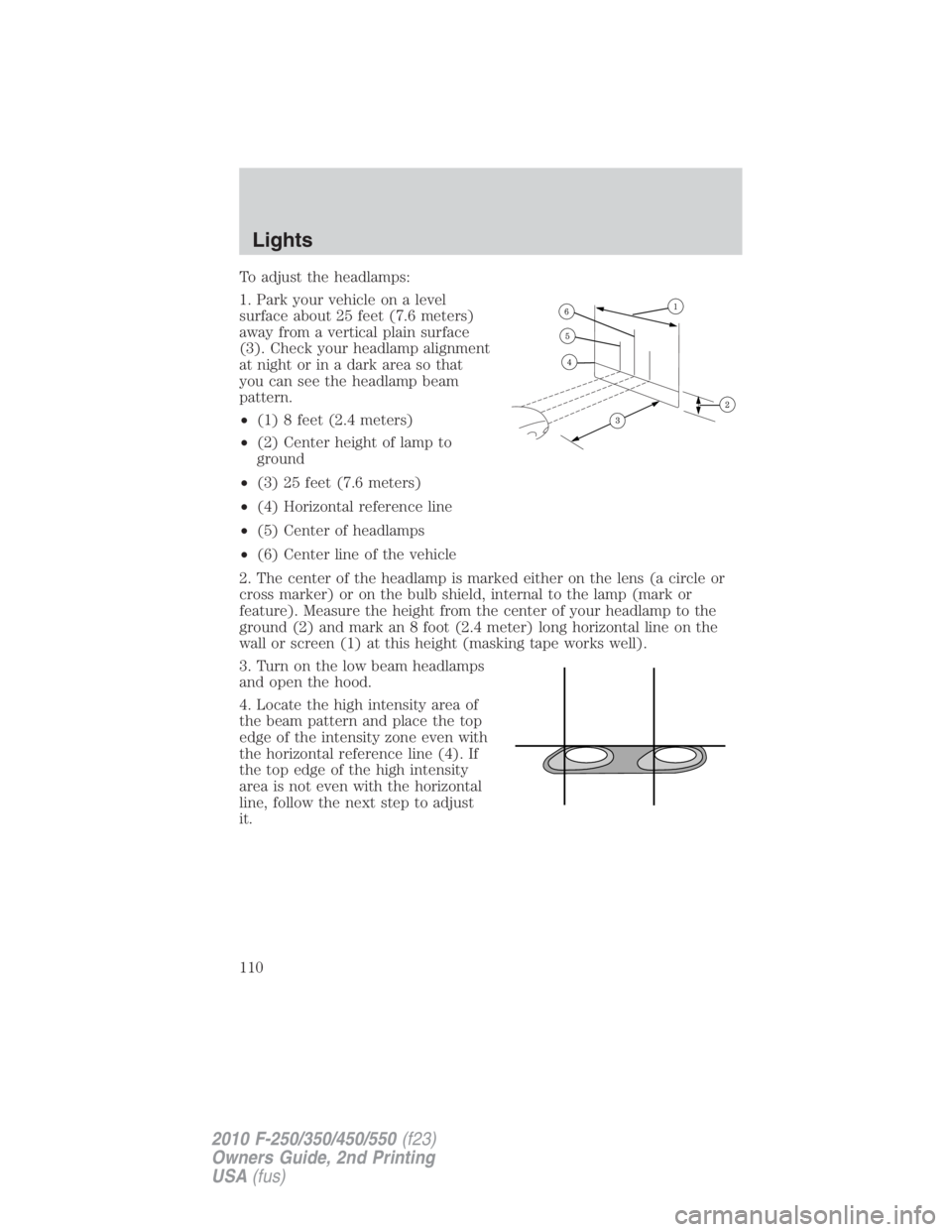
To adjust the headlamps:
1. Park your vehicle on a level
surface about 25 feet (7.6 meters)
away from a vertical plain surface
(3). Check your headlamp alignment
at night or in a dark area so that
you can see the headlamp beam
pattern.
• (1) 8 feet (2.4 meters)
• (2) Center height of lamp to
ground
• (3) 25 feet (7.6 meters)
• (4) Horizontal reference line
• (5) Center of headlamps
• (6) Center line of the vehicle
2. The center of the headlamp is marked either on the lens (a circle or
cross marker) or on the bulb shield, internal to the lamp (mark or
feature). Measure the height from the center of your headlamp to the
ground (2) and mark an 8 foot (2.4 meter) long horizontal line on the
wall or screen (1) at this height (masking tape works well).
3. Turn on the low beam headlamps
and open the hood.
4. Locate the high intensity area of
the beam pattern and place the top
edge of the intensity zone even with
the horizontal reference line (4). If
the top edge of the high intensity
area is not even with the horizontal
line, follow the next step to adjust
it.Lights
110
2010 F-250/350/450/550 (f23)
Owners Guide, 2nd Printing
USA (fus)